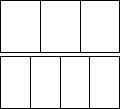Larger fractions
|
a)
|
Circle which number is larger out of 1313 or 1414. Show or explain how you know this.
|
|
|
b)
|
Circle which number is larger out of 2323 or 3434. Show or explain how you know this.
|
|
|
c)
|
Circle which number is larger out of 610610or 1212. Show or explain how you know this.
|
| Y4 (11/2005) | ||
| a) |
1/3 and explanation involving any 1 of the following:
|
difficult |
| b) |
3/4 and explanation involving any 1 of the following:
|
very difficult |
| c) |
6/10 and explanation involving any 1 of the following:
|
very difficult |
Based on a representative sample of 183 Year 4 students.
NOTE:
Each of the questions is optimally solved using a different strategy: partitioning knowledge, difference to a whole, and difference to a half respectively. Encourage students to look at the range of different strategies used by the group/class and discuss which are more efficient or accurate, and identify which best suits the fractions being compared. By trying to use the same strategy for a different question an insufficient explanation may result.
| Common response | Likely misconception | |
|
a)
b) c) |
1/4 > 1/3 because 4 is bigger than 3 3/4 > 2/3 because 3 & 4 are bigger than 2 & 3. 6/10 > 1/2 because 6 & 10 are bigger than 1 & 2. |
Applying rules for whole numbers, and not recognising that a fraction is a rational number (a/b) |
| a) - c) | Insufficient diagram showing only the largest fraction (similar to repeating the answer in the first part). | Students do not understand that to compare two fractions both must be represented to offer a valid comparison. |
|
b) c) |
2/3 1/2 …because the lower the denominator the bigger the pieces. |
Students do not understand that to compare non-unit fractions they must consider the relationship between the top and the bottom number. This simple rule for partitioning does not allow for this. |
| a) - c) |
"[fraction] is bigger" (repeating the answer in the first part). |
Students do not understand what is required for an "explanation" |
| c) | 2/3 and 3/4 are both the same/equal. | Students know they are one "piece" from 1 but are not taking into account the size of the pieces. |
Students who respond that "the larger the number on the bottom the smaller the fraction/pieces" for question a) may be reciting something they have memorised without understanding. Students could develop misconceptions that will lead to problems when they move on to looking at or comparing non-unit fractions. This rule is not transferable to the non-unit fraction comparisons in questions b) and c). Check that students can offer another explanation or representation to justify their answer.
Students who think that "the larger the numbers the larger the fraction" are likely to be applying these rules based on their experiences with whole numbers and do not recognise that fractions are rational numbers and therefore a different kind of number. This is one of the least sophisticated misconceptions around comparing fractions.
Students with this misconception will state 1/4 > 1/3 , 3/4 > 2/3 and 6/10 > 1/2 .
NOTE: the latter two comparison are correct, but for incorrect reasons.

- Use two rectangle shapes the same size;
- Partition one into 3 parts and the other into 4 parts;
- Lay these next to each other and discuss which unit fraction is larger.
Students can further explore question b) by building up 2/3 and 3/4 and comparing which is larger. For question c) students could explore what a half would be if the denominator is 10 and then compare to 6/10 . Finish this exercise by removing the representations and encourage students to solve similar comparison problems by visualising the fractions in their head.
Students who thought that both 2/3 and 3/4 were equal because they were only one piece away from a whole could use the two rectangles (as shown above), construct representations of the fractions and look at the difference to 1.
Students that answered with an insufficient explanation, or simply repeated that one was larger without further elaboration, need to have a "sufficient" explanation modelled and made explicit to them. A summary of what makes an explanation sufficient is:
- specific details;
- appropriate use of examples;
- justification;
- clarity to another reader.
Further teacher and peer modelling of a sufficient explanation should also help supplement their understanding of what is needed in an explanation. Then address their ideas about constructing each fraction and finding common ground on which to compare them (as described above).
Click on the link to the English resource for further information about writing an explanation

